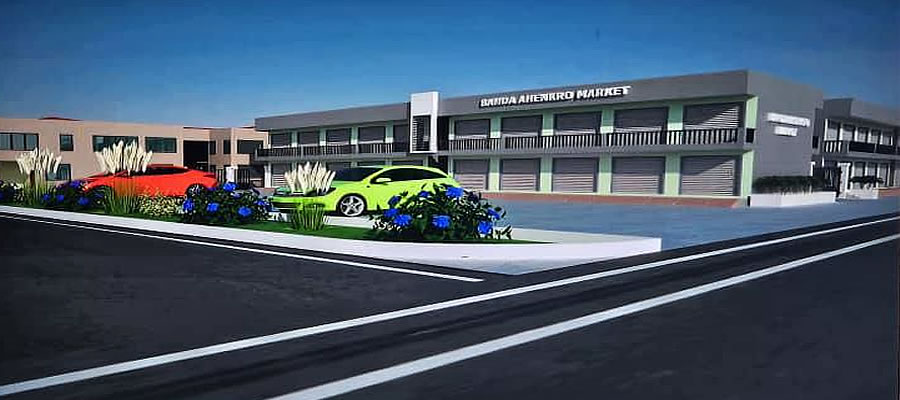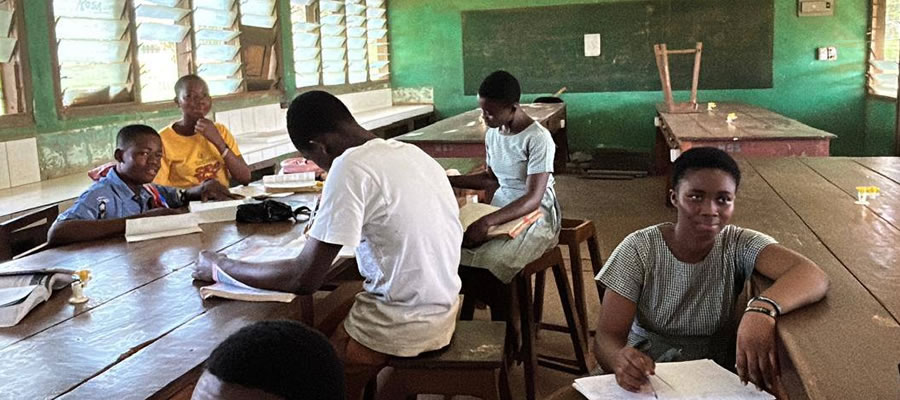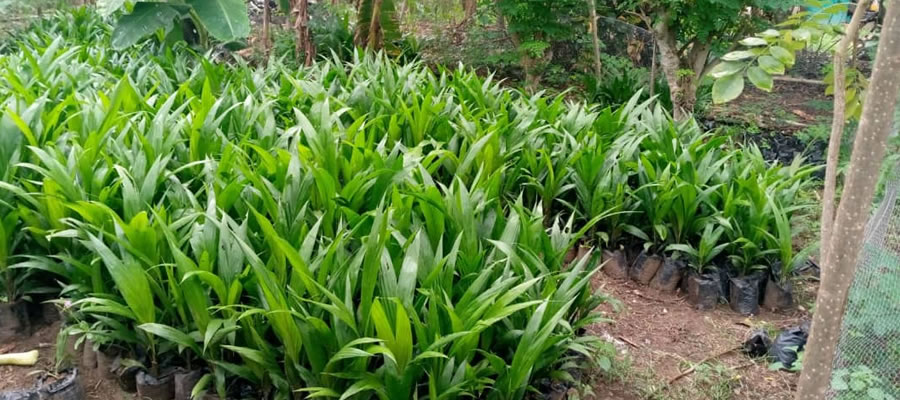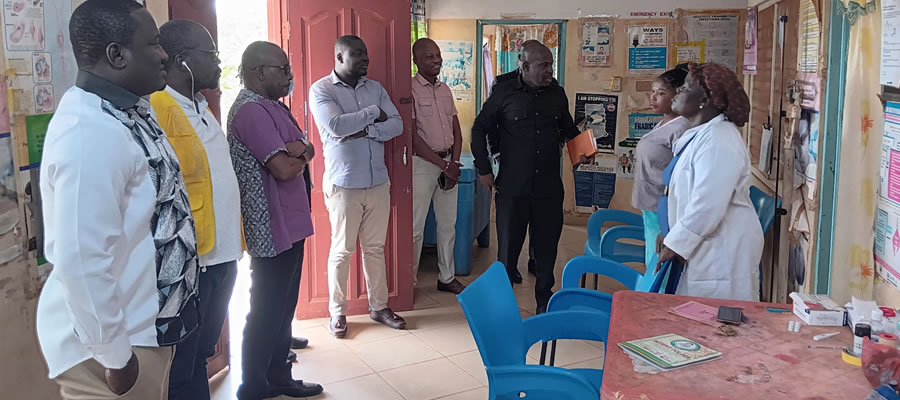

Agriculture continues to be the main stay of the district’s micro economy. The district lies in the forest zone and has vast tract of arable land and favourable rainfall patterns. Ahafo Ano South West District depends predominantly on agriculture for its major source of income, employment and food supply and therefore any meaningful development effort must necessarily be based on improved performance in the sector.
Cash crops such as cocoa, citrus, oil palm, and food crops like cassava, plantain, cocoyam, maize and vegetables like okro and tomatoes are the main agricultural produce in the district. As the major producer of cocoa in the region, it produces an average of 7500 metric tones per annum. The major producing areas are Kunsu, Wioso and Mpasaso among others.
The District produces a large volume of vegetables and it is about the second to Akomadan area in Ashanti. Sabronum, Nsuta, Ahwerewam and Abesewa areas are well noted for the cultivation of tomatoes. While Asempanaye and Dwenewoho are noted for okro. People travel from within and without the district and region to purchase the vegetables. Generally the food crops are exported to Kumasi, Accra and beyond. However, lack of storage and processing facilities has telling effects on the production levels. This could only be reduced if there are ready markets and/or the vegetables are processed locally.
Rice, even though has great potential in the district, is grown by peasant farmers whose capital outlay is very low and so it is grown on subsistence level. Areas like Mankranso, Kunsu, Dwinyama, Biemso No.1 and Potrikrom are noted for rice production.
Rice Project at Biemso No. 1(SAWA)
The total land area for the project is 80 hectares, out of which 10 hectares have been cultivated. The estimated yield is about 20 tons per annum. However, lack of adequate supply of water is the major problem. With the SAWA System (bounding) Rice could be cultivated three (3) times a year if there is adequate supply of water. Rice production is, however, done once a year due to the problem of water. This calls for irrigation facilities.
Production Estimates of Major Crops
Agricultural activities in the district operate at a very low level of productivity. Production levels only increase with an increase in the acreage under cultivation. The productivity of farmers generally is very low. Average yield per hectare (national) is about 40 per cent of achievable yields. The district average yield for cassava, cocoyam and plantain are higher than the regional average. Table 10 depicts the yields per hectare for the district and region.
Agricultural activities in Ahafo Ano South West have not seen any meaningful structural change over the years. Small-scale farmers (subsistence) who predominantly depend on traditional farming methods, which destroy forest and degrade soil, dominate this sector.
The average farm size is about an acre or two. Most farmers have more than one farm and they depend on hired labour especially for land preparation. Agricultural activities and output depend heavily on rainfall (natural conditions) and therefore any changes or variations in rainfall patterns affect agricultural outputs. Tables 11 and 12 reveal the yields per hectare and the areas cropped in hectares under the major crops respectively.
Livestock
Animal husbandry is increasingly becoming an important economic activity in the district economy. In most of the settlements, sheep, goats and birds (hen and cocks) are reared at the backyards to provide additional income and as protein supplement. The field survey revealed that there is no veterinary officer in the district and therefore the farmers have no access to veterinary services. This negatively impact on the development of the livestock industry. Furthermore, the forest vegetation greatly limits the number of cattle which could be reared in the district.
Fisheries
Fish farming has caught up with people of Ahafo Ano South West. The district has therefore been identified among 21 districts as having great potential for fish farming in the country. Suitable areas include Kunsu and Dwinyama. There are currently 25 fish ponds in the district (covering an area of 4.29 hectares) at Dwinyama, Kunsu, Biemso No. I & II and Akwatiakrom. The type of fish farmed at these locations are snake head (koboo), tilapia and chrsialithys (kontro).
Key Development Problems of Agriculture
The development problems of agriculture, which is the mainstay of the district economy, are many and interrelated and therefore need to be dealt with holistically.
The problems include:
Low production/productivity: Most of the operators in this sector heavily rely on the traditional and obsolete farming methods. Only a few percentages of farmers use modern, improved farming technology due to most operators’ poor attitude to the improved methods of farming. The low production is also due to high cost of labour/inputs, land tenure system, lack of access to information, over dependence on government for the supply of inputs and ageing farmers.
Over-dependence on rain-fed agriculture: Agriculture activities in the district are tied to rainfall. The rainfall regime therefore affects the production levels. The unreliable rainfall distribution is a major cause of fluctuation in crop production. Added to this are the seasonal nature of rivers/streams and the high cost of irrigation equipment.
Limited access to credit: Almost all the farmers in the district, especially food crop farming, have no access to credit but depend on their own resources to operate. This causes the farmers to sell their crops to the market women who sometimes finance them at low prices immediately after harvest. The other sources of credit to the farmers include private moneylenders and financial institutions whose demands the farmers cannot afford.
Lack of storage facilities: Storage facilities are not available in the district to store food crops after harvest resulting in high post harvest losses which have negative impact in the economy.
Inadequate number of Agricultural Extension Agents (AEAs): The low turnout of AEAs from the agricultural institutions negatively impinge on the sector. There are only 20 AEAs in the district meaning the extension officer – farmer ratio is 1:2,171 compared to the national standard of 1:300. The inadequate number of AEAs adds to the farmers’ unwillingness to change.
Limited market and infrastructural back-up: Even though the district is close to Kumasi, the regional capital, the poor nature of the roads, the unprocessed nature of the crops and market restrictions prevent the farmers from taking advantage of proximity to the regional and metro market.
High cost of farming inputs: The low income levels of the operators in this sector as a result of low production have prevented the farmers from being able to purchase farming inputs at high cost.
Encroachment on forest reserves and wildlife: This is being done by the farmers and hunters.
Pollution of Water Bodies: Water bodies are being polluted by the use of chemicals especially by vegetable farmers at Sabronum and Mankranso areas. Animals especially cattle also pollute the water bodies. Affected rivers include Subin, Adansua and Mankran.
Arable Land
This district is endowed with arable land. About 80 percent of the land is suitable for crop cultivation with around 60% of the arable land being under cultivation. Maize, rice, cassava, yam, cocoyam, and plantain are the main food crops cultivated. The soils and the rainfall regime do support different types of agricultural produce such as citrus, cocoa, oil palm, plantain, cassava, tomatoes, maize and rice. Some settlements like Wioso, Ahwerewam and Sabronum, which lie along the forest reserves experience severe shortage of farmlands. There is encroachment on forest reserves for farming activities and also for wildlife. According to the farmers, the fertile forest reserves are being wasted.
Forest Resources
The district is endowed with forest resources, which include commercial timber of high economic value like odum, wawa, kyenkyen and other lesser-known species. A considerable number of the members of the communities depend either directly or indirectly on the forest for their livelihood. The major source of domestic energy is the fuel wood.
The activities of illegal timber operators especially chain saw operators are fast depleting the tree stock and degrading the forest. Attakrom, Dwinyama, Wioso and Mpasaso areas have excessively been degraded. Bush fires have devastated part of the Tinte Forest Reserves around Nsuta and Fawomang. The other forest resource in the district, which is of commercial value, is bamboo.
Minerals
Gold, bauxite, manganese, quarry stone, clay deposits and sand and stones form the mineral resource base of the district. Areas like Kunsu, Sabronum, and Barniekrom have gold deposits. Evidence exist at Kunsu, Dwinyama and Sabronum as old mining sites. Prospecting activities have been completed at Mpasaso, Mankranso, Kunsu, Bonkwaso and Sabronum. In fact viability has been established at the Bonkwaso site. It is envisaged that actual mining will start in the foreseeable future.
Bauxite deposits are found at Aya Hills and Mpasaso as part of the Nyinahin Bauxite deposits. Considerable deposits of manganese are found at Asirebuso Camp, 5 kilometres South of Mpasaso. Clay deposits found at Hwibaa-Wioso-Asuadei Biemso II and Mankranso have been tested by the Building and Road Research Institute (B.R.R.I) as one of the richest in the country. The Assembly and the B.R.R.I are looking for investors in this area. Other mineral resources include quarry stone at Pokukrom. These physical resources could promote cottage industries, community development and construction activities.
Production Systems and Level Of Technology
Being a predominantly rural district, farming is the main productive activity. The 2000 population and housing report indicate that about 63.2% of the working population are directly engaged in subsistence farming. Traditional farming practices such as use of cutlasses, hoes and bush burning are the dominant methods used. The district lags behind in the use of improved farming methods.
Cocoa, cassava, tomatoes, plantain, maize and cocoyam are the most essential crops. Women dominate food crop cultivation and therefore foodstuff marketing remains an important source of employment for them. However, males dominate tomato cultivation.
Agro Processing
Processing of agricultural products is very important when one considers marketing of agricultural products. However, this activity is virtually absent in the district. So far, the District Assembly in collaboration with European Union and Village Infrastructure Project have supported two groups at Barniekrom and Boatengkrom to acquire Gari processing plants.
Date Created : 11/16/2017 2:14:01 AM










 facebook
facebook
 twitter
twitter
 Youtube
Youtube
 +233 593 831 280
+233 593 831 280 0800 430 430
0800 430 430 GPS: GE-231-4383
GPS: GE-231-4383 info@ghanadistricts.com
info@ghanadistricts.com Box GP1044, Accra, Ghana
Box GP1044, Accra, Ghana